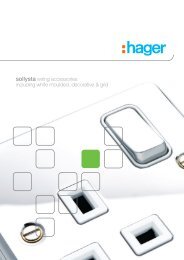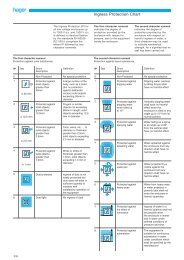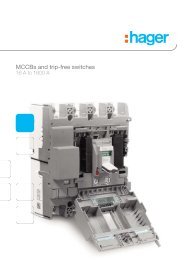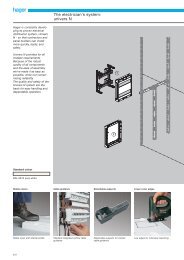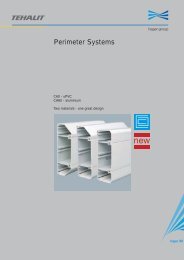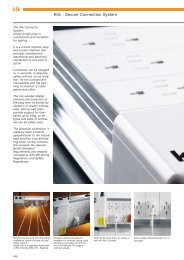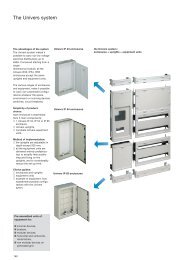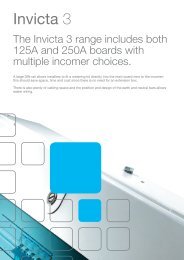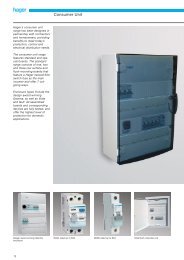Create successful ePaper yourself
Turn your PDF publications into a flip-book with our unique Google optimized e-Paper software.
<strong>Eco</strong>-<strong>ficient</strong> <strong>Solutions</strong><br />
Make energy and cost saving your business
<strong>Eco</strong>-<strong>ficient</strong> <strong>Solutions</strong><br />
The need to save energy<br />
Since the Kyoto Protocol Treaty, more and more emphasis<br />
has been put on the need for energy saving awareness<br />
affecting individuals and businesses alike. The treaty outlined<br />
targets for developed countries to reduce their CO2<br />
emissions; a challenging task due to the increasing use of<br />
cars and industrial development.<br />
An outcome from the Kyoto Protocol was that the European<br />
Unity issued various directives, aimed at analysing and<br />
optimising energy consumption within the member states,<br />
in particular the Energy Performance of Building Directive<br />
(EPBD).<br />
This Directive has shaped Part L of the Building Regulations<br />
in Ireland and Northern Ireland, aimed specifically at<br />
reducing energy consumption in both dwelling and<br />
non-dwelling buildings.<br />
Building Energy Certificate (BER)<br />
All buildings must have a building energy certificate (BER), as<br />
issued by your local authority. This gives builders and<br />
developers an opportunity to upgrade the energy<br />
performance of existing or new installations.<br />
Government Incentives<br />
Governments are keen to encourage users and installers<br />
wherever possible to use energy ef<strong>ficient</strong> equipment. This is<br />
usually in the form of tax relief schemes that allow companies<br />
to write off 100% of the purchase value of approved energy<br />
ef<strong>ficient</strong> equipment in the year of purchase. Please contact<br />
your local authority on how to claim these benefits.
Total<br />
67% 33%<br />
Health<br />
63% 11% 4% 12% 9%<br />
Education<br />
51% 15% 2% 11% 12% 9%<br />
Communication<br />
& Transport<br />
Sports & Leisure<br />
48% 16% 7% 8% 2%<br />
20%<br />
43% 17% 10% 15% 4% 10%<br />
Other<br />
43% 15% 5% 6% 4% 26%<br />
Retail<br />
35% 32% 5% 8% 4% 16%<br />
Warehouses<br />
34% 23% 10% 9% 3% 23%<br />
Offices<br />
32% 22% 21% 3% 15% 6%<br />
Hotel and Catering<br />
32% 12% 11% 34% 1% 10%<br />
Government<br />
26% 24% 7% 11% 17% 15%<br />
0 10 20 30 40 50 60 70 80 90 100%<br />
Lighting<br />
Heating & Hot Water Cooling & Ventilation Catering Computing Other<br />
The Role of Lighting in Energy Consumption<br />
Extensive research has been conducted by the Chartered<br />
Institute of Building Services Engineers (CIBSE) on the role<br />
of lighting in energy consumption and has published in its<br />
Energy Efficiency in Lighting report:<br />
“The total number of units of electricity consumed by the<br />
lighting installation will be affected by the length of time the<br />
lighting is switched on, which depends on the amount of<br />
daylight that is present and whether the room is occupied,<br />
but also whether there are suitable controls, either manual<br />
or automatic, to ensure optimum lighting conditions without<br />
lights being left on unnecessarily.”<br />
In the service sector up to 40% of electricity is used for<br />
lighting alone so taking effective control of this can make<br />
significant savings in energy and reduce costs.<br />
Simple but effective lighting controls can include time<br />
switches, dimmers and programmers, and can provide<br />
significant benefits in the reduction of energy. Additionally<br />
they are easy to use and can be installed either in new or<br />
retrofit applications.<br />
More automated solutions can be provided with occupancy<br />
sensors, daylight sensors, pre-programmed light levels and<br />
zoned lighting control with specifically designed lighting<br />
systems, which can be designed at the new build stage or<br />
installed later as a retro fit.<br />
* the data above is provided by CIBSE
Simple Energy Saving <strong>Solutions</strong> - DIN rail mounted<br />
time switches<br />
Time based switches such as time switches and<br />
programmers provide selectable on-off periods during the<br />
day, week and year or a combination of all to control<br />
various electrical loads.<br />
Simple and effective energy savings can be achieved by<br />
setting these devices so that the various loads are only<br />
switched on when they are actually needed, thereby saving<br />
unnecessary usage of energy.<br />
The hager range of timers include electro-mechanical time<br />
switches with an analogue display, and have 1 channel for<br />
daily or weekly programming. These products are ideal for<br />
controlling loads such as lighting, heating and shop window<br />
displays etc.<br />
Digital time switches have been developed with more<br />
programmable flexibility for daily, weekly and yearly timing<br />
functions where a more varied level of control is required in<br />
domestic and commercial applications.<br />
An optional Programme Key is available on some models to<br />
provide easy backup to a PC and quick re-installation of the<br />
programme.<br />
Hinged cover to protect the<br />
display and buttons<br />
Backlit for easier use<br />
(EG103E and EG203E)<br />
Bar graph visual of the daily<br />
programme.<br />
Only 4 buttons for easy<br />
navigation<br />
Direct programming key for<br />
transferring programme<br />
settings from a PC with<br />
programming softwtare.<br />
The 1&2 channel digital timer switches, including the yearly EG400<br />
programmers, can be programmed via the built-in interface or via<br />
the PC programmed software (supplied).<br />
A print out of the programme<br />
can be produced for the project<br />
and kept in the distribution file<br />
for future reference.<br />
Different keys can be used to<br />
adapt the installation for<br />
different uses.<br />
Programmes for holiday and<br />
shutdown periods can also be<br />
programmed.<br />
A double click on the programme<br />
step is enough to<br />
quickly modify the programme.<br />
The programme can then be<br />
saved on the PC and or be<br />
transferred to the EG005/<br />
EG002 key via the EG003<br />
interface.
Electromechanical Time switches (Din Rail Mounted)<br />
2 Module Analogue Time switches<br />
Technical<br />
Characteristics<br />
EH010 EH011 EH110 EH111 EH171 EH191 EH209 EH210 EH211 EH271<br />
Width in<br />
modules 1 1 3 3 3 5 2 2 2 2<br />
17.5mm<br />
Voltage Supply 230V 230V 230V 230V 230V 230V 230V 230V 230V 230V<br />
Operating<br />
Cycle<br />
Minimum<br />
Switching<br />
Supply failure<br />
reserve<br />
Manual<br />
Override<br />
24 hrs. 24 hrs. 24 hrs. 24 hrs. 7 days<br />
15 min 15 min 15 min 15 min 2 hrs.<br />
24 hrs. /<br />
7 days<br />
15 mins<br />
/ 2 hrs.<br />
24 hrs. 24 hrs. 24 hrs. 7 days<br />
30 min 30 min 30 min 3.5 hrs.<br />
- 200 hrs. - 200 hrs. 200 hrs. 200 hrs. - - 200 hrs. 200 hrs.<br />
Auto /<br />
On<br />
Auto /<br />
On<br />
Auto /<br />
On / Off<br />
Auto /<br />
On / Off<br />
Auto /<br />
On / Off<br />
Auto /<br />
On / Off<br />
On / Off On / Off On / Off On / Off<br />
Digital Time switches (Din Rail Mounted)<br />
Technical<br />
Characteristics<br />
EG010 EG071 EG110 EG170 EG103B/E EG171 EG210 EG270 EG203B/E EG470<br />
Width in<br />
modules<br />
17.5mm<br />
1 1 3 3 2 3 3 3 2 5<br />
Voltage Supply 230V 230V 230V 230V 230V<br />
Operating<br />
Cycle<br />
230V &<br />
DC<br />
110 /<br />
230V<br />
110 /<br />
230V<br />
24 hrs. 7 days 24 hrs. 7 days 7 days 7 days 24 hrs. 7 days 7 days 7 days<br />
Program Steps 5 20 20 20 56 20 20 20 56 84<br />
230V<br />
230V<br />
No. of Channels 1 1 1 1 1 1 (pulsed) 2 2 2 4<br />
from <strong>Hager</strong><br />
2 Module Analogue Timeswitches,<br />
with or without clock hands
Simple Energy Saving <strong>Solutions</strong> - Time switches<br />
Astronomical time switches are programmed in weekly cycles<br />
in accordance with their geographical location. Functions<br />
include automatic change of winter and summer time, making<br />
this type of switch ideal for energy savings for commercial<br />
and residential applications, especially the programming for<br />
holiday periods and bank holidays.<br />
Staircase timers provide control of lighting circuits with<br />
automatic switch off after a pre-set time. This makes them<br />
ideal for energy saving in corridor or staircase type<br />
applications, with pre-warning of switch off and double delay<br />
functions for the occupant’s safety.<br />
Yearly Time switches<br />
Technical<br />
Characteristics<br />
EG493E EG293B EG403E<br />
Width in<br />
modules 17.5mm<br />
5 3 3<br />
Voltage Supply 230V 230V 230V<br />
Operating Cycle 7 days 7 days 7 days<br />
Program Steps 300 300 300<br />
No. of Channels 4 2 4<br />
from <strong>Hager</strong><br />
Yearly time switches - 2 and 4<br />
channels
Astronomical Time switches Staircase Timers<br />
Technical<br />
Characteristics<br />
EE180 EE181 EMN001 EMN005<br />
Width in<br />
modules 17.5mm 2 2 1 2<br />
Voltage Supply 230V 230V 230V 230V<br />
Operating Cycle 7 days 7 days<br />
Time Delay - -<br />
30 secs to<br />
10 mins<br />
(1 hour<br />
if button<br />
pressed)<br />
30 secs to<br />
10 mins<br />
(1 hour<br />
if button<br />
pressed)<br />
No. of Channels 1 2 - -<br />
A typical application example for energy saving using<br />
EG493 yearly time switches<br />
To reduce energy and hence running costs, a four channel<br />
yearly time switch could be installed in a small office or<br />
business property.<br />
One channel could be used to control the lighting during the<br />
evening to reduce unnecessary usage of energy. Another<br />
channel could be used to ensure that storage heating is not<br />
used over the weekends and bank holidays when the building<br />
is unoccupied. A third channel could be used to control the<br />
external advertising or building signage during unnecessary<br />
periods e.g. between 10pm to 7am. The final channel on the<br />
yearly timeswitch could be used to control the<br />
immersion heating function, again, to ensure that the water in<br />
the building will not be turned on during weekends and / or<br />
bank holidays.<br />
An example of potential savings from the first channel<br />
example above are shown below:<br />
Lighting Configuration “Light On” Time Consumption<br />
Max power density 10W/m 2<br />
Typical large office space<br />
300m 2<br />
11 hrs / 260 days + 1 weekend + 1 night<br />
a month<br />
11244 kWh / year<br />
Max power density 10W/m 2<br />
Typical large office space<br />
300m 2<br />
11 hrs / 260 days<br />
Saving<br />
8580 kWh / year<br />
2664 kWh / year<br />
25% Energy Saving
Simple Energy Saving <strong>Solutions</strong> -<br />
Motion and Presence detectors<br />
Motion detectors are designed to detect movements such as<br />
a person walking through a building, stairways and corridors<br />
for example. Presence detectors are designed for detecting<br />
smaller movements such as people working at a desk.<br />
from <strong>Hager</strong><br />
IP55 Motion Sensor<br />
140º - 360º<br />
Motion detectors are particularly effective when used in low<br />
use areas such as bathrooms, toilets and storerooms when<br />
the lighting will only be activated when the area is occupied,<br />
thereby saving energy.<br />
Presence detectors are ideal for controlling lighting in office<br />
spaces as they not only detect large movements but also<br />
smaller activities such as people working, so that they are not<br />
left in darkness. When the area is left unoccupied the lighting<br />
will be switched off thereby minimising the energy usage of<br />
the area.<br />
Some motion and presence detectors include a photocell<br />
which senses natural daylight and can be used to control the<br />
lighting during periods of high ambient natural lighting levels,<br />
thus avoiding the use of unnecessary energy.<br />
from <strong>Hager</strong><br />
Flush Mounted<br />
Occupancy Sensor<br />
Function<br />
▼<br />
Flush<br />
Mount<br />
Surface<br />
Mount<br />
Presence<br />
Detection<br />
Motion<br />
Detection<br />
Variable<br />
Timeout<br />
Photocell<br />
Lux<br />
Setting<br />
Switch<br />
Override<br />
OS2/AP • • • • •<br />
OS2/APSM • • • • •<br />
OSFM • • • • •<br />
OSSM • • • • •<br />
EE810 • • • • • •<br />
EE811 • • • • • •<br />
EE812 • • • • • • •<br />
EE804 • • • • •<br />
EE805 • • • • •<br />
EE85x • < 16m • • •<br />
EE86x • < 16m • • •<br />
EE87x • < 16m • • •
A typical application example for energy savings using<br />
motion and presence detectors<br />
In a large commercial building or office complex motion<br />
detectors could be installed in the toilet and storage areas,<br />
and presence detectors fitted in the office areas. With the<br />
additional benefit of daylight sensing this means that the<br />
lighting throughout the building would be optimised to match<br />
the occupancy levels in every area. Some typical examples of<br />
savings per area can be seen in the table below:<br />
Energy Saving Potential through use of Occupancy Sensors<br />
Storage Rooms<br />
Corridors<br />
Toilet Areas<br />
Conference Room<br />
Training Room<br />
Open Plan Office<br />
Single Occupant Office<br />
0 10 20 30 40 50 60 70 80 90 100<br />
Potential Energy Saving*<br />
Absence<br />
Detection<br />
Remote<br />
Control<br />
Remote<br />
Programming<br />
N o of<br />
Channels<br />
Dimming<br />
Control<br />
Daylight<br />
Harvesting<br />
BMS<br />
Integration<br />
Comments<br />
• • • 1 No<br />
• • • 1 No<br />
• • 1 No<br />
• • 1 No<br />
Klik applications and<br />
absence detection<br />
Standard presence<br />
detection<br />
1 No<br />
1 No<br />
1 1-10V • •<br />
Rectangular detection<br />
area<br />
1 No<br />
1 No<br />
Standard motion<br />
detection<br />
• • 1 No<br />
• • 1 No<br />
• • 1 No<br />
IP55 for outdoor and<br />
indoor use with 16m<br />
frontal detection<br />
* e-source
Simple Energy Saving <strong>Solutions</strong> -<br />
Lighting Dimmers and Twilight Switches<br />
Modern dimmers use phase control to reduce or increase<br />
the average voltage to the lighting load. The diagram below<br />
shows this process in a graphical format.<br />
Switch On<br />
Switch On<br />
On<br />
Off<br />
Off<br />
Switch Off<br />
On<br />
This dimming method therefore provides opportunities for<br />
energy savings as it reduces the total power consumed for<br />
lighting under dimmed situations; these panel mounted<br />
versions can be controlled by using external pushbuttons or<br />
switches.<br />
The table below shows the range of DIN rail mounted<br />
dimmers available from hager, which are suitable for all light<br />
sources including incandescent, LV and LVL halogen, and<br />
fluorescent ballast.<br />
A typical energy saving application using panel mounted<br />
dimmers.<br />
A large restaurant having two walls, made almost entirely<br />
from windows, has dimmable lighting installed to allow each<br />
dining area to be individually adjusted, by external<br />
pushbuttons, to the required light ambience. During daylight<br />
occupancy the areas nearest the windows are adjusted to<br />
use the benefit of natural daylight hence saving energy during<br />
this period.<br />
Technical Features<br />
Controls available:<br />
On the product<br />
External with illuminated pushbutton<br />
Input 1/10V<br />
Ambient lighting setting<br />
300W 600W 1000W Pilot 1/10V<br />
EV011<br />
EV012<br />
-<br />
Yes<br />
-<br />
-<br />
EV002<br />
EV004<br />
Yes<br />
Yes<br />
-<br />
1 (EV004)<br />
EV100 EV102 EV106 EV108<br />
Yes<br />
Yes<br />
Yes (Slave)<br />
-<br />
Yes<br />
Yes<br />
Yes (Slave)<br />
2 Levels<br />
Yes<br />
Yes<br />
-<br />
-<br />
Yes<br />
Yes<br />
-<br />
2 Levels<br />
Types of outputs:<br />
Direct (capacitive / inductive load)<br />
Input 1/10V<br />
Yes<br />
-<br />
Yes<br />
-<br />
Yes<br />
-<br />
Yes<br />
Yes (Master)<br />
-<br />
Yes<br />
-<br />
Yes<br />
Functions:<br />
Protection overheating / overloads<br />
Level indicator<br />
Memorisation<br />
Softstart<br />
Yes*<br />
-<br />
Yes<br />
Yes<br />
Yes<br />
EV004<br />
Yes<br />
Yes<br />
Yes<br />
-<br />
Yes<br />
Yes<br />
Yes<br />
Yes<br />
Yes<br />
Yes<br />
Yes<br />
Yes<br />
Yes<br />
-<br />
Yes<br />
Yes<br />
Yes<br />
-<br />
Parameter settings:<br />
Mini, max, level<br />
Dimmind speed<br />
Speed at start / stop<br />
Transition speed for level call<br />
-<br />
-<br />
-<br />
-<br />
EV004<br />
EV004<br />
EV004<br />
-<br />
Yes<br />
-<br />
-<br />
-<br />
Yes<br />
Yes<br />
Yes<br />
Yes<br />
Yes<br />
Yes<br />
Yes<br />
Yes<br />
Yes<br />
Yes<br />
Yes<br />
Yes<br />
*EV011: protection via integrated fuse, electronic protection for other products.
Light Detection ~ twilight switches<br />
Light detection products such as twilight switches operate by<br />
sensing ambient light and switching on or off against a preset<br />
lux level. Generally the lighting will be unnecessary during<br />
certain periods of the day and therefore energy will be saved<br />
when controlled by these devices.<br />
The table below shows the range of twilight switches<br />
available, which can be used for effective lighting control in<br />
public areas such as shopping malls, street lighting and<br />
illuminated display areas.<br />
Twilight Switches<br />
Technical<br />
Characteristics<br />
EE100 EE101 EE110 EE170 EE171<br />
Width in<br />
modules 17.5mm 3 3 5 3 3<br />
Operating Cycles - -<br />
Program Steps - -<br />
24<br />
hrs.<br />
15<br />
mins<br />
7<br />
days<br />
7<br />
days<br />
1 min 1 min<br />
Voltage Supply 230V 230V 230V 230V 230V<br />
No. of Channels - - 1 1 1<br />
These wall mounted manual dimmer units can be used to<br />
control small loads of lighting, up to 400W. The level of light<br />
in the room can be set by way of the dimmer switch, ensuring<br />
that only the necessary amount of light is being used<br />
Wall Dimmers<br />
Technical<br />
Characteristics<br />
PSD1/M PSD2/M PSD3/M PSD4/M<br />
Gang 1 2 3 4<br />
Way 2 2 2 2<br />
W Max 400W 250 250W 250W<br />
Fixing Centres 60.3mm 60.3mm 120.6mm 120.6mm<br />
Mounting box<br />
min flush<br />
25mm 25mm 25mm 25mm
Simple Energy Saving <strong>Solutions</strong> -<br />
Product Combinations<br />
Example 2:<br />
Products used:<br />
Scene control<br />
Time Switch EG203E<br />
& Dimmer EV102<br />
By combining the operations of a dimmer and time switch<br />
significant energy savings can be realised.<br />
The previous pages of this document have shown typical<br />
applications of stand-alone products to provide energy<br />
saving solutions, however by combining some of these<br />
products even greater reductions in energy consumption can<br />
be achieved.<br />
As most applications are unique in their use of energy and<br />
have different lighting requirements, the following examples<br />
may be of help in determining what could be possible to<br />
further enhance the reductions in energy usage and cost.<br />
The products are easy to install, can be fitted in standard<br />
modular enclosures based on the 17.5mm design and can<br />
be quickly mounted on DIN rail. They are easy to set and<br />
programme and therefore can be changed for future<br />
requirements.<br />
Overall the installation can contribute to the improvements in<br />
the energy performance rating of the building.<br />
The 2 channel weekly time switch can be used to control the<br />
lighting more effectively during the evenings and weekends<br />
when the building is unoccupied. The heating can be similarly<br />
switched off during these same unoccupied periods.<br />
Additionally the time switch can also be programmed with<br />
dimmers so that the lighting can be dimmed at certain times<br />
during the day. For example the first setting could be in the<br />
morning when the lighting could be dimmed as the natural<br />
daylight could be suf<strong>ficient</strong> to provide enough ambient light.<br />
The dimmer could be operated later in the afternoon as<br />
daylight reduces and eventually reaching full lighting levels<br />
during the evening. The overall effect will be to only use<br />
energy when it is actually needed.<br />
Benefits:<br />
• The time switch ensures that the lighting and heating is<br />
only used when they are needed and do not rely on people<br />
to remember to switch them off.<br />
• Energy consumption is further reduced with the dimmer<br />
control so that the lighting matches the occupant’s<br />
requirements against available usable daylight levels.<br />
Example 1:<br />
Products used:<br />
Dynamic lighting<br />
Presence detector<br />
EE812 & Dimmer<br />
EV102<br />
Example 3:<br />
Products used:<br />
External building<br />
signage control<br />
Time switch EG103E<br />
& Twilight switch<br />
EE171<br />
The combination of the presence detector coupled with the<br />
dimmer provides a simple but effective control of lighting<br />
whilst reducing energy.<br />
The presence detector senses movement in the building and<br />
controls the lighting depending on occupancy activity.<br />
In addition the presence detector senses the varying ambient<br />
light levels in the building from windows, skylights etc. and<br />
provides a controlled output to the dimmer to maintain the<br />
required preset constant level of lighting for the occupants.<br />
Benefits:<br />
• The presence detector ensures that the lighting is switched<br />
off when the building is unoccupied.<br />
• The presence detector maximises the use of daylight to<br />
minimise the use of artificial lighting.<br />
Combining these two products provides an effective use of<br />
exterior building signage based on daylight and night time<br />
requirements.<br />
The twilight switch is programmed to ensure that the exterior<br />
signage only activates against a preset low level of daylight,<br />
ie switches on at dusk and switches off at dawn.<br />
With the addition of a time switch further controls can be<br />
integrated to control signage use over weekends, when it may<br />
not be needed.<br />
Benefits:<br />
• The twilight switch minimises the energy usage during a<br />
24 hour day<br />
• The “holiday” mode of the time switch EG103E provides<br />
additional energy savings by switching off signage completely<br />
during closed periods.
Simple Energy Saving <strong>Solutions</strong> - Metering<br />
As the saying goes “if you do<br />
not measure it - you can not<br />
improve it”. Kilowatt hours<br />
meters measure the active<br />
energy used in an electric<br />
installation. This allows the<br />
separate measurement of<br />
energy consumption in<br />
different areas of a large<br />
facility, with the purpose of<br />
allocating energy usage to<br />
different cost centres. The<br />
initial readings can be used<br />
as a baseline for<br />
determining energy usage,<br />
and the subsequent readings<br />
can be useful in identifying<br />
energy saving or wastage.<br />
These values can also be<br />
important for calculating<br />
payback times. The range<br />
includes meters with pulsed<br />
output for remote<br />
indication or linking into an<br />
energy management system.<br />
Kwh meters can be used for<br />
local metering or monitoring<br />
of power consumption in<br />
individual machines.<br />
Part References<br />
Single phase direct measure<br />
EC050 EC051 EC110 EC111 EC112 EC120 EC121<br />
Accuracy acc IEC1036 Class 1 (1%) 0.02 to 32A~ Class 2 (2%) 0.32 to 32A~ Class 2 (2%)<br />
I max 32A ~ direct 32A ~ direct C.T. 100 / 5A<br />
Network Single phase 230V ~ 50Hz Single phase 230V~ 50 / 60Hz<br />
Counter<br />
Total without reset<br />
Total<br />
without<br />
reset<br />
Total + partial with reset<br />
Single phase 230V~ 50 /<br />
60Hz<br />
Total + partial with reset<br />
Width 1 mod 3 mod 3 mod<br />
Part References<br />
Three phase direct measure<br />
Three phase direct measure via CT<br />
EC310 EC311 EC320 EC321<br />
Accuracy acc IEC1036 Class 2 (2%) Class 2 (2%)<br />
I max 80A ~ direct C.T. 50 at 1500 / 5A<br />
Network<br />
Three phase Tri / 500V 50 / 60Hz<br />
with or without N<br />
3 x C.T. / 1 x C.T. 400V ~<br />
Tri / Tri + N 400V ~ 2 phase<br />
Counter Total + partial with reset Total + partial with reset<br />
Width 7 mod 4 mod<br />
EC051 - Single Phase Kwh<br />
Meter<br />
EC320 - Three Phase Kwh<br />
Meter<br />
SR300 - Current Transformer
Energy Saving - Klik Lighting System<br />
As lighting consumes the largest amount of energy in most<br />
commercial buildings, accounting for 40% in the service<br />
sector, it makes sense to manage it effectively.<br />
As part of the market leading Klik range, Klik Digital is a<br />
simple, cost effective ‘plug & play’ system, already<br />
creating energy efficiencies at DLVA Swansea, Nottingham<br />
Trent University, Arsenal’s Emirates Stadium, Coventry Ricoh<br />
Arena and BOC Cambuslang to name but a few.<br />
Using a proven design based on the very successful Klik<br />
Lighting Distribution System (KLDS), the Klik Digital<br />
Connection System (KDCS), has marshalling boxes in 4, 6, 8,<br />
or 10 way configurations and pre-wired plugs for distribution<br />
of power and data to digital ballasts (DALI & DSI).<br />
Positioning of Sensors<br />
KDCS makes best use of the available natural daylight. The<br />
digital sensors will regulate the light level in accordance with<br />
the natural daylight and light provided from adjacent<br />
luminaries.<br />
In this example KDCS is installed around the edge of the<br />
room where natural daylight is available.<br />
Digital<br />
Occupancy<br />
Sensor<br />
Standard<br />
Occupancy<br />
Sensor<br />
KLDS<br />
KDCS<br />
Digital<br />
Dimmable<br />
Luminaires<br />
Standard<br />
Luminaires<br />
Occupancy Sensor Positioning<br />
Occupancy Sensor Spacing<br />
Sensor direction<br />
Best detection is achieved by walking across the<br />
detector beams not towards them. This should be considered<br />
for natural corridors.<br />
1m overlap<br />
Increase the level of overlap to reduce the possibility of dead<br />
spots.
Energy Saving - Klik Lighting System<br />
KDCS can be used when an installation uses digital dimmable<br />
luminaires throughout. It can also be used in conjunction<br />
with KLDS if digital dimming is not required throughout the<br />
installation. This has the benefit of reducing the capital costs<br />
without compromising the performance.<br />
The following provides a comparison between Klik LDS and Klik DCS part number references:<br />
Klik LDS<br />
Klik DCS<br />
Marshalling boxes KLDS4 KDCS4<br />
KLDS6<br />
KDCS6<br />
KLDS8<br />
KDCS8<br />
KLDS10<br />
KDCS10<br />
KLDS12<br />
Pre-wired plugs P22/1.0LSF/2 P55/2<br />
P22/1.0LSF/3 P55/3<br />
P22/1.0LSF/4 P55/4<br />
P22/1.0LSF/5 P55/5<br />
P64AXR/1.0LSF/2<br />
P55AXR/2<br />
P64AXR/1.0LSF/3<br />
P55AXR/3<br />
P64AXR/1.0LSF/4<br />
P55AXR/4<br />
P64AXR/1.0LSF/5<br />
P55AXR/5<br />
Occupancy sensor OS2/AP OS3/D (for DSI ballasts)<br />
OS2/APSM<br />
OS4/D (for DALI ballasts)<br />
OS3/DS (for DSI ballasts)<br />
OS4/DS (for DALI ballasts)<br />
OS3/DSW (for DSI ballasts)<br />
OS3/DSW (for DALI ballasts)<br />
Controller & OSDC OSDP<br />
Programmer
Energy Saving <strong>Solutions</strong> - Tebis TX<br />
Tebis TX technology can achieve true energy savings through<br />
building automation. Maximum energy savings are achieved<br />
where the system controls digital lighting and heating.<br />
Configuring the system for both automatic switching of<br />
lighting / heating plus predetermined timed settings is<br />
simplicity itself. In addition, by using daylight linking PIR<br />
devices to dim lighting in response to natural lighting<br />
availability, energy savings can be maximised. This alone<br />
has been proven to cut lighting energy consumption by up to<br />
70%*.<br />
Source: Building Energy Research Group, Department of<br />
Buidling and Construction, City University of Hong Kong<br />
Lighting Control<br />
Switch all lights on or off or dim<br />
from a main switch point<br />
manually or automatically<br />
depending on time of day,<br />
whether a space is occupied or<br />
even on the level of natural light<br />
available.<br />
Heating Control<br />
Constant in-room temperature<br />
display. Controlled manually,<br />
automatically or using remote<br />
control.<br />
Shutter / Blind Control<br />
Open or shut blinds and<br />
shutters manually,<br />
automatically or using remote<br />
control.<br />
Scene Setting & Scheduling<br />
Set a scene with one<br />
button to close blinds and dim<br />
lighting for a presentation for<br />
example, or schedule blinds to<br />
close and heating to lower at<br />
the end of each day.<br />
In Room LCD Display<br />
Shows temperature, time of<br />
day, state of circuits and can<br />
be used as four switch inputs<br />
eg set for after hours cleaning<br />
or offices / store closed etc.<br />
Remote Control Interface<br />
Hand held remote gives total<br />
control of lighting, heating,<br />
shutters and blinds wherever<br />
you are in the room.<br />
Tebis TX is highly flexible and can accommodate changes<br />
during installations and even after commissioning.<br />
Coupled with real potential for energy saving, this makes<br />
Tebis TX a truly future proof system.
Case Study -<br />
Flexible Control For New University Extension<br />
McGills Electrical has used <strong>Hager</strong>’s Tebis bus based system<br />
to supply a future proofed and flexible central lighting control<br />
solution for the University of Dundee’s new 6,500m2 library<br />
extension.<br />
Using Tebis, McGills installed a single 30V bus line throughout<br />
the extension. A conventional hardwired solution would have<br />
used multiple cables. All the lighting circuits and switches<br />
controlling them then simply tap onto the bus line via<br />
connectors.<br />
Says Graham Sutherland, project manager for McGills:<br />
“Providing a solution for switching several lighting circuits<br />
supplied from different distribution boards can be a major<br />
exercise.<br />
“A conventional hardwired solution would have involved<br />
multi-core cabling throughout the building, all being<br />
terminated into one central grid switching unit. Apart from the<br />
logistics of terminating several cables into the correct switch<br />
there is no flexibility to change specifications during the build.<br />
Any change in switching control would involve extra cabling.”<br />
Using Tebis each input and output device is assigned an<br />
address and then programmed so certain lighting circuits only<br />
respond to signals from particular switches. Individual circuits<br />
can respond to more than one switch, so an infinite number<br />
of switching variations are possible using the system.<br />
The bus system also makes it easy to check the emergency<br />
lighting. Someone simply switches off all the lighting circuits<br />
to simulate a mains failure for a walk test.<br />
Says Sutherland: “We probably saved about 20% labour<br />
time using Tebis compared to conventional hard wiring. More<br />
importantly however the system gives us the flexibility to<br />
change or add to the specification without having to run new<br />
cabling throughout the<br />
building.”<br />
The new extension provides students with IT and WiFi<br />
facilities, integrates other libraries into one central building<br />
and provides additional room for research.
Case Study -<br />
Protection and energy saving solution for Tesco<br />
Homeplus<br />
Contractor Essex Electrical Group Plc has used <strong>Hager</strong><br />
distribution boards to provide both circuit protection and a<br />
simple energy saving control solution for Tesco’s new<br />
Homeplus stores.<br />
To date Tesco is trialling seven non-food stores under the<br />
brand Homeplus. In common with the group’s corporate<br />
policy, the stores aim to minimise their use of energy. Each<br />
store has a sales area of more than 30,000 sq ft.<br />
<strong>Hager</strong> distribution boards provide all the circuit protection.<br />
The company’s contactors, time switches and photocells also<br />
provide lighting control. Lighting can account for more than<br />
50% of the energy usage in a retail outlet so this was a key<br />
energy saving initiative.<br />
Typically each store has a panelboard with a mains incomer<br />
of either 400A or 630A. This then feeds up to 12<br />
sub-distribution boards, most of which are TP&N but with<br />
some SP&N boards.<br />
The lighting control uses a combination of a master<br />
keyswitch, digital time switches and photocells all of which<br />
switch the luminaires via contactors. The lighting circuits are<br />
split so that 40% can be switched on for cleaning and/or<br />
shelf stacking, with the remaining 60% switched on when the<br />
store is open to the public.<br />
The master key switch turns on 40% of the lighting at the<br />
beginning of the shift and then turns off all the lighting at the<br />
end of the day. Digital time switches switch on the remaining<br />
lights when the store opens and also turn off 60% of the<br />
lighting when the store closes to the public, for shelf stacking<br />
and cleaning, and finally the remaining circuits at the end of<br />
the day.<br />
In addition photocells turn the lighting circuits on or off in<br />
response to natural daylight levels. Roof lights maximise the<br />
amount of natural light available.<br />
Comments Andy Collinge, contracts manager for Essex<br />
Electrical Group: “Tesco has opted for simple but effective<br />
control of their lighting in their new Homeplus stores. Using<br />
time clocks and photocells for automatic switching removes<br />
the responsibility from the staff and ensures an energy<br />
ef<strong>ficient</strong> solution.<br />
“Using <strong>Hager</strong>’s digital timers saved us a lot of installation<br />
time. Not only do they have a weekly cycle option to account<br />
for different opening times, but they also have an intelligent<br />
key that can be pre-programmed with the desired settings.<br />
“For multiple installations with several lighting circuits that are<br />
the same, using these timers saved a lot of commissioning<br />
time. It also ensures that the different stores have the same<br />
lighting control for consistency and if the opening times need<br />
altering this can be done quickly and with minimum<br />
disruption.”
Case Study -<br />
Gateshead Schools Klik into Digital Lighting Control<br />
Gateshead council is using <strong>Hager</strong>’s Klik DCS for digital<br />
lighting control in its primary schools to help teachers get<br />
more effective use of interactive wipeboards and to help save<br />
energy.<br />
Klik DCS consists of a marshalling box, which distributes<br />
both power and data to the HF ballasts, and a programmable<br />
sensor that combines movement detection with daylight<br />
linking and allows scene setting. Using the system the<br />
lighting is switched on to a programmed ambient light level<br />
when movement is detected and then switched off or dimmed<br />
down when no movement is detected after a preset time.<br />
In addition to maintaining a constant ambient light level, the<br />
system is programmed with different scene sets so if the<br />
interactive wipe board is used the teacher can adjust the<br />
lighting using a simple remote control. The remote control<br />
also allows manual dimming up and down of the lighting.<br />
All primary schools in Gateshead council are being upgraded<br />
to digital lighting in an ongoing rollout programme.Comments<br />
Peter Fallen, electrical engineer for Gateshead council: “We<br />
specified Klik DCS because it is a cost-effective and easy<br />
means of giving us the digital lighting control that we need.<br />
The system is fast to install, causing minimum disruption and<br />
typically takes just 10 minutes to commission for each<br />
classroom. Another advantage is that we need no<br />
commissioning engineers to programme the system, our<br />
electricians can do it themselves while they are on site.<br />
“In addition future maintenance is simple, since Klik DCS is<br />
a plug and play system if there is a fault a luminaire can be<br />
simply unplugged and replaced with minimal disruption.”
More innovative solutions from hager:<br />
The Media Hub: patch panel solution<br />
The <strong>Hager</strong> Media Hub is essentially the patchpanel<br />
enclosure for the home. The standard version available from<br />
<strong>Hager</strong> features the award-winning Gamma enclosure which<br />
provides the neat solution of linking all<br />
the Cat5e and Coax cabling in one central<br />
place – enabling the networking of TV,<br />
Internet and telephone – giving the end<br />
user the latest in data transfer abilities.<br />
The simple installation method makes it<br />
easy for the installer too – contact hager<br />
for full details and<br />
training information.<br />
Apartment Solution<br />
(1 Row)<br />
Standard House<br />
Solution<br />
(1 Row, 26 Mod)<br />
Standard House<br />
Solution<br />
(2 Row, 26 mod with<br />
mounting plate)<br />
Flush <strong>Solutions</strong>...<br />
Volta Flush Mounting Enclosures<br />
Kit out your installation in style with these flush mounting distribution enclosures. With a metal door as<br />
standard, 1 to 4 row, and 12 to 48 module spaces, these enclosures keep your installation neat and safe.<br />
Wide range of door colours and finishes available:<br />
FW Flush Enclosures<br />
The new FW Flush Cabinets from <strong>Hager</strong> offer reliability and<br />
flexibility. They are ideal for housing protection devices as<br />
well as home automation or multimedia equipment. From 36<br />
to 288 modules.<br />
Installers see the increase in the demand for fitting additional<br />
devices such as modems or TV equipment in the distribution<br />
board. The FW Cabinets allow for the fitting of such devices<br />
by way of a mounting plate which comes with or can be fitted<br />
into the board, or can be fitted retrospectively. Cable entries<br />
on the top and bottom come as standard.<br />
<strong>Hager</strong> Ltd.<br />
Unit M2<br />
Furry Park Industrial Estate<br />
Swords Road<br />
Santry<br />
Dublin 9<br />
Ireland<br />
Tel: +353 (1) 883 5844<br />
Fax: +353 (1) 8869520<br />
www.hager.ie<br />
info@hager.ie<br />
For full details on these products<br />
and more, please call us to order<br />
a copy of our General Catalogue<br />
or just visit www.hager.ie



